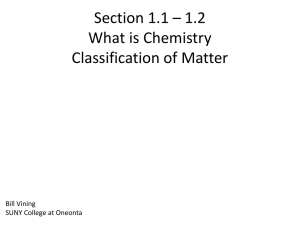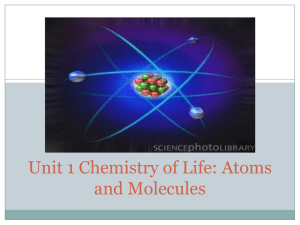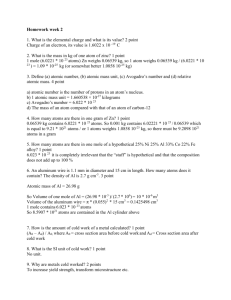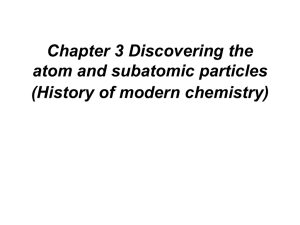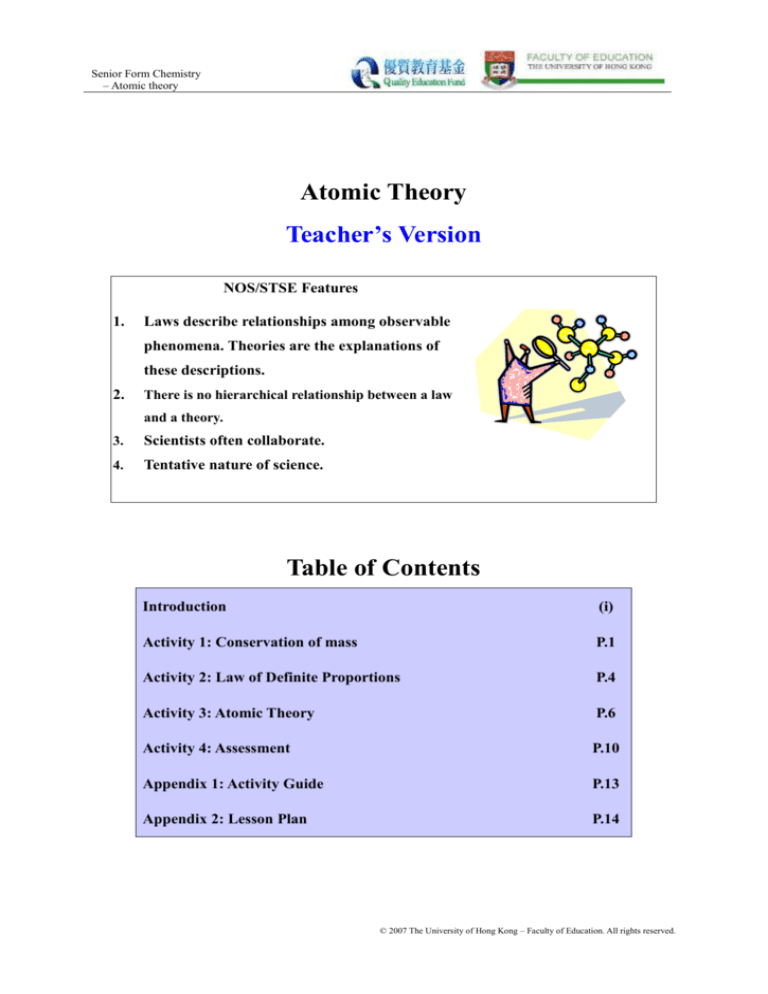
Senior Form Chemistry
– Atomic theory
Atomic Theory
Teacher’s Version
NOS/STSE Features
1.
Laws describe relationships among observable
phenomena. Theories are the explanations of
these descriptions.
2.
There is no hierarchical relationship between a law
and a theory.
3.
Scientists often collaborate.
4.
Tentative nature of science.
Table of Contents
Introduction
(i)
Activity 1: Conservation of mass
P.1
Activity 2: Law of Definite Proportions
P.4
Activity 3: Atomic Theory
P.6
Activity 4: Assessment
P.10
Appendix 1: Activity Guide
P.13
Appendix 2: Lesson Plan
P.14
© 2007 The University of Hong Kong – Faculty of Education. All rights reserved.
Senior Form Chemistry
– Atomic theory
Introduction
Rationale
1.
While students may not have much difficulty in reciting or stating the Law of
Conservation of Mass, extensive research on students’ understanding has demonstrated
that many of them are not able to apply the law in new situations or to think with the aid
of the law. While we frequently refer to the Law of Conservation of Mass in our teaching
of chemistry, surprisingly the law is not addressed in the chemistry curriculum or
textbooks explicitly. It is believed that if students learn it consciously and through a
variety of activities, they can have a stronger foundation for learning other chemistry
concepts. For the teaching or learning activities about the law, please see Activity One
and the Assessment Tasks.
2.
Performance of Hong Kong (HK) Form 2 students in international comparative studies
of science achievement shows that they are not very capable of drawing conclusions
from experiment results. For example this question from the Trends in International
Mathematics and Science Study (TIMSS) conducted in 1999.
Two open bottles, one filled with vinegar and the other with olive oil, were left on
a window sill in the sun. Several days later it was observed that the bottles were no
longer full. What can be concluded from this observation?
(A) Vinegar evaporates faster than olive oil.
(B) Olive oil evaporates faster than vinegar.
(C) Both vinegar and olive oil evaporate.
(D) Only liquids containing water evaporate.
(E) Direct sunlight is needed for evaporation.
6%
3%
49% *
17%
25%
Less than half of the HK students were able to choose the correct answer. Although
drawing a conclusion from data is part of our science curriculum objectives, it is
suspected that students either (i) sometimes take their ‘experiment result’ as the
‘conclusion’ or (ii) do not have sufficient training in this aspect. In an attempt to tackle
this, please see Activity Two.
3.
Many people believe that a ‘law’ states knowledge that has been “proven” while a
‘theory’ is something that has not yet been confirmed. In fact, generally speaking, a ‘law’
(i)
© 2007 The University of Hong Kong – Faculty of Education. All rights reserved.
Senior Form Chemistry
– Atomic theory
is a generalized statement about the empirical world; a ‘theory’ can be regarded as an
explanation of some phenomena. For example, the pressure law states that, in a fixed
mass and volume of gas, the temperature of the gas sample varies in direct proportion to
its pressure. It should be noted that the pressure law (i) is not absolute – the behaviour of
real gases can deviate from it; and (ii) does not explain why gases, real or ideal, behave
like this anyway. To make sense of the properties of gas, the kinetic theory of gases was
put forward. From this example, we do not see any hierarchical relationships between
‘law’ and ‘theory’. They are simply complementary in helping us to better understand
nature.
In most instances, atomic theory is presented to students without addressing the scientific
context concerning John Dalton who proposed the theory in 1808. A historical analysis
reveals that the theory was an attempt to explain the ‘Law of Conservation of Mass’ (1774,
Antoine Lavoisier) (Please refer to Activity One) and the ‘Law of Definite Proportions’ (1774,
Joseph Proust) (Please refer to Activity Two). It is hoped that, through this package, students
can understand (i) how science can be developed through the emergence of laws and
subsequently, overarching theories that explain many physical phenomena; (ii) a possible
relationship between a law and a theory; (iii) significant scientific knowledge can develop not
only from direct experimental findings or observation. As we have seen, the two laws offer no
direct evidence or proof of the existence of atoms. Dalton had not seen atoms. (Lavoisier
had openly spoken against atomic theory, because he had no knowledge of atoms from
experiments.)
Level of study
Number of lessons
Form 3 – Form 6
3 lessons (each lesson 35-40 minutes)
Contents
1. Introducing the Law of Conservation of Mass
2. Discovery of the Law of Definite Proportions
3. Atomic theory as the explanation to the laws.
4. Assessment of students’ learning
Teaching package includes
1. Worksheets (Teacher’s Version and Student’s Version)
2. A Teaching PowerPoint
(ii)
© 2007 The University of Hong Kong – Faculty of Education. All rights reserved.
Senior Form Chemistry
– Atomic theory
Activity 1
Conservation of mass
When I eat a hamburger, will my
body mass increase by the mass of the
hamburger?
If a piece of magnesium is burnt, will there be a gain or a loss
in mass? Think about it!
Remarks: The setup is weighed before and after burning. (See video 2)
Results of investigation:
Mass of set up before burning = 26.093 g
Mass of set up after burning = 26.141 g
Change in mass = + 0.048 g
This is not a closed system. There will be a gain or loss of mass. In this case, the gain in mass
results from the reactions of oxygen or nitrogen with magnesium.
Now divide into groups and conduct one of the following tasks to see whether there are
changes of mass. After the task, present your findings to your classmates.
Notes: The aim of all these activities is to bring out the concept of the conservation of mass, but
not the name of the chemicals or any explanation of the reaction.
1. Measure the mass of 500 cm3 of your
favourite drink. Then compare your body
mass before and after drinking it.
2. Compare the mass of sodium hydroxide
(NaOH) solution and copper(II) sulphate
(CuSO4) solution with the mass of the
mixture where we can see some
precipitate of Cu(OH) 2.
3. Dissolve 5 g table salt in 100 cm3 of water. Compare
the masses of solute, solvent and the resulting
solution.
P.1
© 2007 The University of Hong Kong – Faculty of Education. All rights reserved.
Senior Form Chemistry
– Atomic theory
What can you conclude from the above investigations?
In none of the cases does the total mass change after any reaction / process. (Conservation of
mass)
[Notes: Teachers would collect students’ findings and bring out the Law of conservation of
mass which was put forward in 1774, ‘In a chemical reaction, the mass of the products is
equal to the mass of the reactants.’ In other words, ‘Matter can neither be created nor
destroyed in any physical or chemical change.’ (A nuclear change also obeys the law of
conservation of mass. In this kind of reaction, the mass change is proportional to the energy to
the energy change i.e. e=mc2.)]
Notes: Teachers need to highlight to students that it was a great discovery. People before
believed that matter can be created or could disappear because of human activity, however,
people had no idea why the law was always true, even after it was put forward.
P.2
© 2007 The University of Hong Kong – Faculty of Education. All rights reserved.
Senior Form Chemistry
– Atomic theory
Extension activity
The Law of Conservation of Mass was put forward by Antoine Lavoisier in 1774. Lavoisier is
known as the father of the modern chemistry. Find out more about his investigations!
Find evidence to answer the following questions in your project:
What were the major discoveries by Lavoisier?
How did he demonstrate the Law of Conservation of Mass?
Did he work alone in all his discoveries?
(Notes: This activity can be considered as a group project. Students may report their findings by
various methods such as PowerPoint, poster, report, etc.)
You can search for information from libraries or the internet. Here are three references:
1. http://www.pbs.org/wgbh/nova/einstein/ance-m.html(English only)
2. http://www.bud.org.tw/museum/s_star20.htm (Chinese only)
3. 多諾萬 (1997) 拉瓦謝: 化學改革與法國革命的先鋒。台北: 牛頓。
Scientists often collaborate.
P.3
© 2007 The University of Hong Kong – Faculty of Education. All rights reserved.
Senior Form Chemistry
– Atomic theory
Activity 2
Law of Definite Proportions
At the end of 1700s, scientists were trying very hard to discover laws or “regularities” in
Nature. Some chemists tried to mix different elements to see how they reacted with each
other. They could measure the mass of the reactants and products very accurately.
Here are some data, or experimental results, they obtained from the reaction of carbon with
oxygen to form carbon dioxide.
Mass of oxygen reacting (g)
Mass of carbon reacting (g)
32
12
64
24
96
36
Under some other conditions, carbon reacts differently with oxygen to produce carbon
monoxide. Here are the data for these reactions:
Mass of oxygen reacting (g)
Mass of carbon reacting (g)
16
12
32
24
48
36
Here are the data for the reaction between copper and oxygen:
Mass of oxygen reacting (g)
Mass of copper reacting (g)
16
64
32
127
48
191
Remarks: The data is not the original data found by scientists in 1700s. Carbon and oxygen are
used to make up a simple case for students. However, students are experiencing the same process
as what scientists did in the past, i.e. to find patterns in the nature.
P.4
© 2007 The University of Hong Kong – Faculty of Education. All rights reserved.
Senior Form Chemistry
– Atomic theory
Can you discover any patterns in these data? Use your own words, draw a conclusion from
these experimental results.
Suggested answers:
There is a constant ratio between the mass of two elements which, on reaction,
produces their products/ the compound.
There is a constant ratio between the mass of oxygen and the mass of carbon which
produces carbon monoxide (CO).
There is a constant ratio between the mass of oxygen and the mass of carbon which
produces carbon dioxide (CO2).
There is a constant ratio between the mass of oxygen and the mass of copper which
produces copper(II) oxide (CuO).
Notes: After the activity, the teacher can bring out the law of definite proportions, ‘A given
chemical compound always contains the same proportion by mass of its constituent elements.’
The law was proposed by Joseph Louis Proust in 1797. Again, this was a great discovery at that
time. However, nobody could explain why elements behaved in this way.
P.5
© 2007 The University of Hong Kong – Faculty of Education. All rights reserved.
Senior Form Chemistry
– Atomic theory
Activity 3
Atomic Theory
The Law of Conservation of Mass and the Law of Definite Proportion were great discoveries.
At that time, nobody could explain the laws. However, in about 1808, John Dalton proposed
the Atomic Theory which can be summarized by four points.
(a) All matter is composed of very small discrete particles.
(b) For elements, the particles are called atoms and are indivisible and indestructible in
chemical reactions.
(c) (i) Each atom of a given element has the same mass. (ii) All atoms of a given element are
identical. (iii) The masses of atoms of different elements are different.
(d) A chemical compound is formed from its elements by the combination of the different
atoms in a fixed ratio for that compound.
How can this theory explain the Law of Conservation of Mass and the Law of Definite
Proportions with reference to activities 1 and 2? Discuss with your classmates.
(a) & (b) Relationship to the Law of Conservation of Mass: if atoms could be destroyed, the mass
of the products in Activity 1 should be less than that of the reactants.
(c) If atoms of different elements are the same, the mass of oxygen should be a simple multiple
of the mass of carbon.
[Probing questions: (1) From the ratio you obtained in Activity 2, do you think the atoms of
oxygen, carbon and copper have the same mass? Explain. (2) From the ratio, can you predict
which atom, oxygen, carbon or copper, has the greatest mass?]
(d) In carbon monoxide, one carbon atom joins to one oxygen atom – 1:1. In carbon dioxide,
one carbon atom joins to two oxygen atoms – 1:2. This illustrates the fixed ratio.
[Probing question: Use your imagination, try to use different kinds of circles to represent
different kinds of atoms and draw the products, carbon monoxide and carbon dioxide.]
P.6
© 2007 The University of Hong Kong – Faculty of Education. All rights reserved.
Senior Form Chemistry
– Atomic theory
What are the differences between a law and a theory?
Laws describe relationships among observable phenomena.
Theories are the explanations of those statements.
In your daily lives, you may be familiar with the law below:
Thermal expansion and contraction
(熱脹冷縮)
Does the law explain the behavior of a material (e.g. a gas) in different temperature? Explain
your answer.
A law only describes natural phenomena but does not explain them. In this case, the
law describes when the material would expand or contract. Scientists proposed the law
to generalize the behaviors of materials at different temperaturess. We can use the law
to predict the behaviors of certain material under different condition but the law itself
gives no explanations of these behaviors. It is the kinetic theory which explains the
behaviors.
(Notes: This question aims to assess students’ understanding of the definition of law.
Students might get the wrong answer and teacher can further discuss the differences
between laws and theories with students.)
Notes: For higher form students, teacher may use the ideal gas law (PV = nRT) as a
substitute for the law of “thermal expansion and contraction”.
You may have also learnt:
Angle of incidence, θi = Angle of reflection, θr
Is it a law or a theory? Explain.
A law (Law of reflection). It describes the phenomenon that the angle of reflection of a
light ray is always equal to its angle of incidence at a flat, smooth reflective surface.
P.7
© 2007 The University of Hong Kong – Faculty of Education. All rights reserved.
Senior Form Chemistry
– Atomic theory
Can you give some others examples of laws and theories that you have learnt?
Examples:
Law:
Newton’s Laws
Mendel’s Laws of Genetics
Theory:
Particle theory of light
Theory of relativity
Genetic theory
Laws describe relationships among observable phenomena. Theories are
the explanations of those statements. There is no hierarchical relationship
between a law and a theory.
Remarks:
The following are different “definitions” of “law” and “theory”:
Laws are generalizations, principles or patterns in nature. (McComas, 1998)
Laws are descriptive statements of relationships among observable phenomena. (Lederman et
al., 2002)
Theories are the explanations of those generalizations (McComas, 1998)
Scientific theories are well-established, highly substantiated, internally consistent systems of
explanations for which much evidence exists. (Adapted from Suppe, 1977, cited in Lederman
et al., 2002)
P.8
© 2007 The University of Hong Kong – Faculty of Education. All rights reserved.
Senior Form Chemistry
– Atomic theory
Extension activity: (The tentative nature of the atomic theory)
In Activity 3, you read about Dalton’s Atomic Theory. Comment on the theory with reference
to your knowledge in Chemistry.
Atomic Theory
(a) All matter is composed of very small discrete particles.
(b) For elements, the particles are called atoms and are indivisible and indestructible in
chemical reactions.
(c) Each atom of a given element has the same mass. (ii) All atoms of a given element are
identical. (iii) The masses of atoms of different elements are different.
(d) A chemical compound is formed from its elements by the combination of the different
atoms in a fixed ratio for that compound.
-“For elements, the particles are called atoms and are indivisible and indestructible in chemical
reactions.”
After the discovery of subatomic particles (e.g. nucleus, proton, electron), atoms are now known
to be able to broken into smaller parts. Atoms are divisible. (e.g. an electron can be taken away
from a sodium atom)
- “Each atom of a given element has the same mass. (ii) All atoms of a given element are
identical”
Isotopes of the same elements are slightly different in mass.
(Notes: The theory proposed by Dalton is not totally accepted today. The Atomic Theory is
modified according to the new evidence.)
Scientific knowledge is subjected to changes.
P.9
© 2007 The University of Hong Kong – Faculty of Education. All rights reserved.
Senior Form Chemistry
– Atomic theory
Activity 4
Assessment
1. Discuss with your neighbours. Please tick the appropriate box.
True
False
(a) The mass of an iron atom in a hammer is greater
than the mass of an iron atom in a nail.
(b) When you change a piece of solid copper into the
liquid state, the mass of each copper atom
decreases.
(c) When you heat a silver ring, it expands. This is
because the silver atoms become bigger.
Don’t
know
2. If you took all of the atoms out of a chair, what would be left? (Circle your answer.)
A.
B.
C.
D.
The chair would still be there, but it would weigh less.
The chair would be exactly the same as it was before.
There would be nothing left of the chair.
Only a pool of liquid would be left on the floor.
[Addition information: Question 2 is a question in TIMSS. The performance of Hong Kong S2
students is shown. Only about half of the students chose the correct answer, (C). ]
Choice
Percentage of
students (%)
P.10
A
33
B
8
C
47*
D
12
© 2007 The University of Hong Kong – Faculty of Education. All rights reserved.
Senior Form Chemistry
– Atomic theory
3. The picture shows some iron atoms on the surface of a piece of iron. When iron rusts,
oxygen atoms react with the iron atoms.
(a) What will be the difference in masses between the iron, compared to the rusted iron?
(Circle your answer.)
A.
The iron is heavier than the rusted iron.
B.
C.
The rusted iron is heavier than the iron.
They have the same mass.
(b) Draw a picture to show what the piece of rusted iron would look like if you could see the
atoms.
There should be circles on the
surface of the pictures indicating
the reaction of oxygen with iron.
(There are more atoms in a piece
of rusted iron.)
P.11
© 2007 The University of Hong Kong – Faculty of Education. All rights reserved.
Senior Form Chemistry
– Atomic theory
4. Compare the mass of the setup before and after CuSO4 crystals have grown.
Explain your answer.
The mass does not change.
(Notes: Teachers may refer students to crystal growing.)
5. Compare the masses of 355cm3 diet coke and 355cm3 regular coke after pouring them out
of the cans. Discuss whether this is related to the Law of Conservation of Mass or not.
Regular coke is heavier than diet coke because the constituents are different (sugars and
sweeteners)
[Remarks: Sweeteners in diet coke includes aspartame (天冬胺), cyclamic acid and its
sodium, potassium and calcium salts (環己基氨基磺酸及其鈉鹽、鉀鹽和鈣鹽 ) and
acesulfame potassium (醋磺內酯鉀).]
P.12
© 2007 The University of Hong Kong – Faculty of Education. All rights reserved.
Senior Form Chemistry
– Atomic theory
P.13
© 2007 The University of Hong Kong – Faculty of Education. All rights reserved.
Senior Form Chemistry
– Atomic theory
Appendix 1 Activity Guide
Materials
Activity 1
Burning of Magnesium
1. Bunsen burner
2. Safety screen and UV shield (any materials that can filter UV light)
3. Magnesium ribbon
4. Tongs
Caution:
a. The burning of magnesium is extremely bright and produces ultraviolet light. Avoid
looking directly at it. A UV shield should be used to protect the eyes.
b. A CO2 fire extinguisher does not put out the flame. In case of fire, a dry-chemical fire
extinguisher must be used instead.
Task 1
1. 500 ml of water / any drinks
2. Electronic bathroom scale (For measuring changes in body mass after drinking; better
with an accuracy of 10-100 g)
[For higher accuracy, schools may purchase an electronic scale with + 20g. This can be
bought from Sam Hing Scales Fty. Ltd. (三興磅廠) (http://www.samhing.com.hk/) at about
$2000. Alternatively, schools may buy an electronic bathroom scale with + 100g from
department stores e.g. WingOn at about $500.]
Task 2
1. Sodium hydroxide solution (1M)
2. Copper(II) sulphate solution
3. Test tubes for mixing solutions
Take the mass of the
two solutions
4. Electronic balance
Task 3
1. 5 g salt
2. 100 cm3 water
3. Electronic balance
P.14
Mix the two
solutions together
Take the reading
again
© 2007 The University of Hong Kong – Faculty of Education. All rights reserved.
Senior Form Chemistry
– Atomic theory
Appendix 2 Lesson plan
Possibility for different teaching sequences:
(1) Activity 1 Activity 2 Activity 3
(2) Activity 1 Activity 3 (a), (b) Activity 2 Activity 3 (c), (d)
Activity 1: Conservation of mass
Time
35 min
Intended Learning Outcomes
Students should be able to
point out that the mass of
reactants is the same as the mass
of product (Law of
Conservation of Mass)
state that matter can neither be
create or destroyed
point out that not all scientific
ideas can be explained at the
time of discovery
draw conclusions from
experimental data
Teaching Flow
Students discuss whether their mass would change
after eating a hamburger.
Teacher shows the videos of burning magnesium to
students.
Teacher discusses with students whether there is
change in mass of a piece of magnesium before and
after burning.
Groups of students are assigned different tasks in
p.3 of the worksheet.
Students draw conclusion from the task.
Teacher collects students’ finding and introduces the
Law of Conservation of Mass.
Materials
Activity 1
worksheet
PowerPoint
(Optional)
Experimental
materials
(stated in
Appendix 1)
Remarks
Teachers need to
highlight to students
that the Law of
Conservation of
Mass (1) was a great
discovery. (2)
However, people
had no idea why the
law was always
true.
Extension activity:
Students divide into groups and investigate
Lavoisier’s life.
P.15
© 2007 The University of Hong Kong – Faculty of Education. All rights reserved.
Senior Form Chemistry
– Atomic theory
Activity 2: Law of definite proportion
Time
15 min
P.16
Intended Learning Outcomes
Students should be able to
generalise natural phenomena
from experimental data
explain the Law of Definite
Proportions
Teaching Flow
Materials
Students study the results of the reactions.
Students discuss the patterns found in the data.
Teacher brings out the Law of Definite Proportions
to students.
Activity 2
worksheet
PowerPoint
(Optional)
Remarks
Teachers need to
highlight to students
that the Law of
Definite Proportions
(1) was a great
discovery. (2)
However, people
had no idea why the
elements behaved in
this way.
© 2007 The University of Hong Kong – Faculty of Education. All rights reserved.
Senior Form Chemistry
– Atomic theory
Activity 3: Atomic theory
Time
Intended Learning Outcomes
35 min
Students should be able to
explain the Law of
Conservation of Mass and the
Law of Definite Proportions
define law and theory
Teaching Flow
Materials
Part (a), (b)
Students discuss whether and how the atomic
theory can explain the phenomenon in activity 1
Part (c), (d)
Students discuss whether and how the atomic
theory can explain the phenomenon in activity 2
Activity 3
worksheet
PowerPoint
(Optional)
Remarks
Parts (a) and (b) can
be discussed after
activity 1.
Law and theory
Students brainstorm examples of law and theories
they learnt
Students discuss the definitions of law and theory.
Teacher round up for students the definitions of
law and theory.
Activity 4: Assessment
Time
15 min
P.17
Intended Learning Outcomes
Students should be able to
predict phenomena by
applying atomic theory in
different situations
Teaching Flow
Materials
Students answer the questions in worksheet.
Teachers discuss the answers with students.
Activity 4
worksheet
PowerPoint
(Optional)
Remarks
This is an assessment
tool to assess
students’
understanding of the
lesson.
© 2007 The University of Hong Kong – Faculty of Education. All rights reserved.





